Burns
Philp & Co Ltd - T.S.S. Marella 1920 to 1948, then owned by an Panamanian
Italian Line with the ship changing names three times from 1948 to 1954,
Please
Note: Firefox and some iPad’s or iPhone’s, etc are not suitable
Use Google Chrome
for this web page to load perfectly!

Click
the logo above to reach the ssMaritime FrontPage for Ships of the Month &
News Updates
With Reuben
Goossens
Maritime Historian, Cruise‘n’Ship Reviewer, Author &
Lecturer
Please Note:
All ssmaritime as well as my other related maritime & cruise sites are 100%
non-commercial and privately owned sites. Be assured that I am NOT associated
with any shipping or cruise companies or agencies or any other organisations!
The author has been in the passenger shipping industry since May 1960, but
although retired and unwell, I occasionally attempt to write an article now and
then, in order to bring enjoyment and pleasure to ship enthusiasts past
passengers and crew.
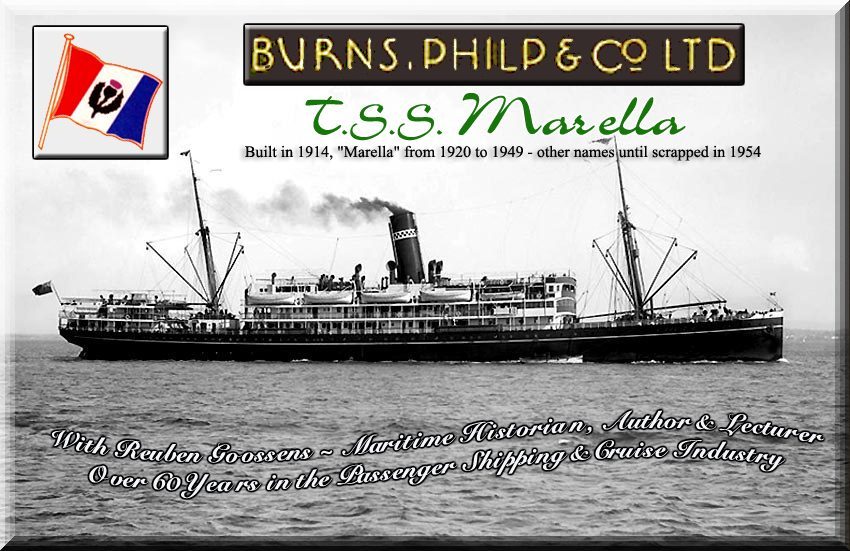
Photographs
are from the ssMaritime historic collection - unless stated otherwise
The T.S.S. Marella was
a 7,475 GRT (Gross Registered Ton) passenger-cargo liner
that was originally constructed by “Reiherstieg
Co” in Hamburg
for the German “Woermann Line”. This well built steel twin-screw
steamship was launched on June 6, 1914, and was duly named “Hilda
Woermann”.
The ship was intended for the Company service between Germany
and South
Africa,
however due to the war her completion was delayed and she remained unfinished
at the builders’ fit-out berth.
Finally work was restarted and she was
completed and handed over to the “Woermann Line” in November 1916,
but was renamed “Wahehe” in 1917, and she was used for
the next 12 months as an accommodation ship until the war ended in November
1918.
In December 1918, the S.S.
Wahehe
was handed over to the “Shipping Controller” in London
as one of the Wartime reparations. The “Wahehe” was placed
under the Management of “Shaw Savill & Albion Co” and at first
she was used as a troop transport ship to return soldiers from various nearby
regions.
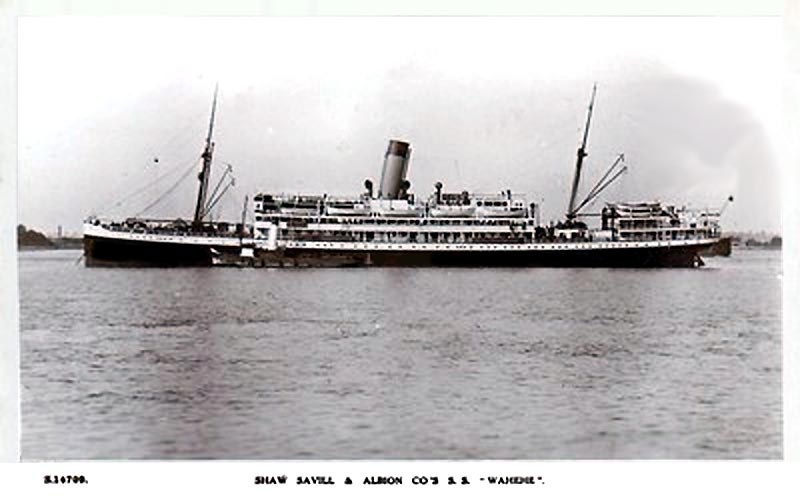
A
postcard of the S.S.
Wahehe
seen in her “Shaw Savill & Albion” livery
However, between May 1919 and June 1920 the S.S.
Wahehe
made three return voyages to Australia
and New
Zealand,
in order to return Australian and New
Zealand
soldiers’ home, as well collecting British soldiers’ from various
locations on the return leg and taking them home.
Finally the “Wahehe” was purchased
from the Shipping Controller, London
by Burns Philp & Co. Ltd and she was renamed
mid “Marella” in 1920.
Burns Philp
Story:
It was in 1883 that Burns Philp and Company
Limited were formed by amalgamating various businesses in Sydney
and Queensland
that had operated in the names of “James
Burns
and Robert Philp & Company”. With James
Burns
as chairman of directors, the company expanded rapidly with a number of
steamers operating from Australian ports to various Pacific
Islands
as well as serviced to New
Zealand
and South-East Asia, including calls to Singapore
and Hong
Kong.

The
Burns Philp House Flag
Robert
Philps
was the Managing Director of Queensland Operations. And had diverse business
interests that included Copra Plantations as well as the Pearling Industry.
They had a good number of ships registered at the main ports’ of their
most frequented calls. Their South Seas Division was created after a complete
takeover of their subsidiary “Robbie, Kaad
& Co”, being re-titled and removing area (Pacific) control from Sydney
to the Fiji
headquarters specific to the Islands'
trades. Other subsidiaries as Hong
Kong
and the Papua-New Guinea Ltd also existed. The changing times during the
1960’s, especially due to the massive discounted airline competition as
well as the arrival of new and advanced cargo handling, including containerisation,
combined with Union demands for Australian crewing, which came together with an
ageing fleet saw the Parent Company cease all Australian shipping operations by
1970. However, Burns Philp will always hold a greatly appreciated and much loved
name within the Australian Passenger Shipping History, for ships like the
Marella and their very last ship the famous Bulolo were outstanding ships!
T.S.S.
Marella:
Having been obtained in October 1920, the now
renamed T.S.S. “Marella” headed for Sydney
where she was given an extensive internal refit and when completed she was
placed on the lengthy Australia
to Indonesia
and Singapore
service.
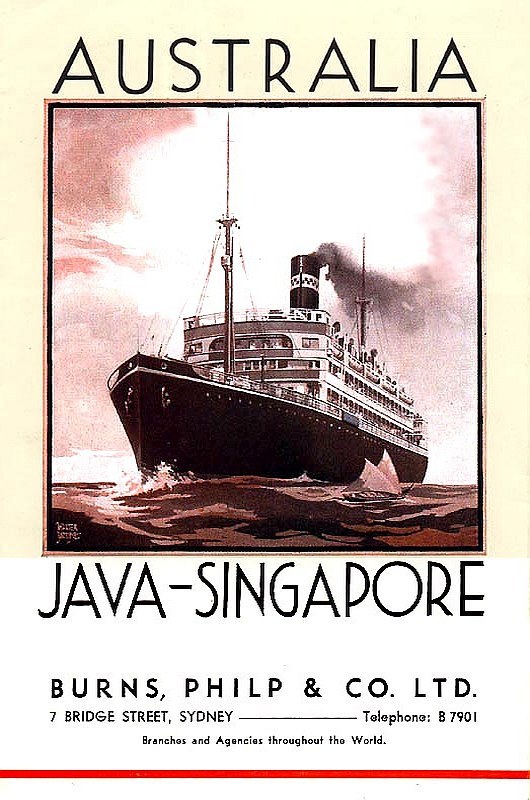

Provided by Dave
Wilding
Above Dave
Wilder
kindly sent me the above image, the cover of the Marella’s Deck Plan, but
sadly the plan section beside it was only a partial one. If anyone can assist
me with a full deck plan, I will be most grateful - Email me at
rg@ssmaritime.com!
As records prove, the Marella and her voyages
became extreamly popular as she was such a beautiful and a luxuriously
appointed liner being known for her lavish interiors as her fittings included
fine marble, but also having some magnificent timbers in her main lounges and
her luxuriously appointed First Class Dinning Room featuring large windows.
However, as the photograph below proves her Second Class Dinning Room was also
of a high standard, being spacious and certainly a light and bright venue
having large windows. In addition, she was the first Passenger Liner to boast a
fully fitted tilled swimming pool.
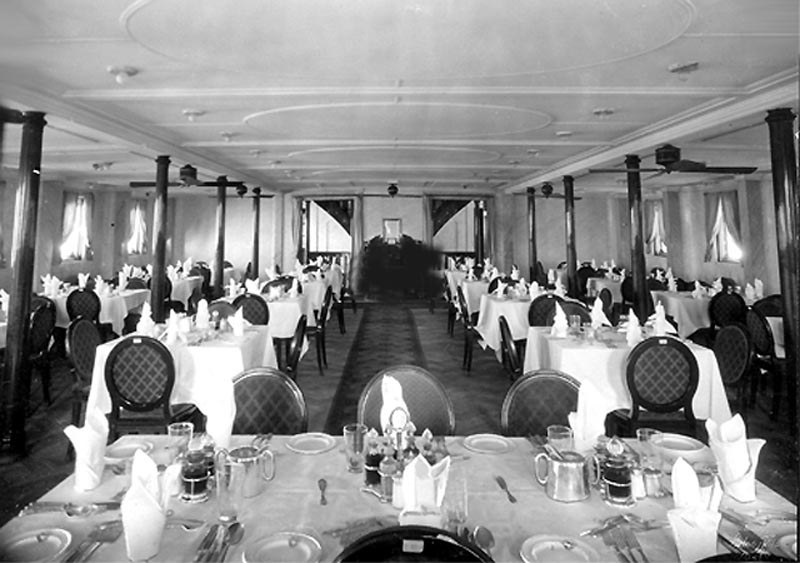
The
Second Class Dinning Saloon
Thus holiday travellers who enjoyed the idea
of an extended ocean vacation visiting many colourful ports decided to book a
full round voyage, in many ways making the T.S.S. Marella one of
Australia’s first luxury cruise ships!
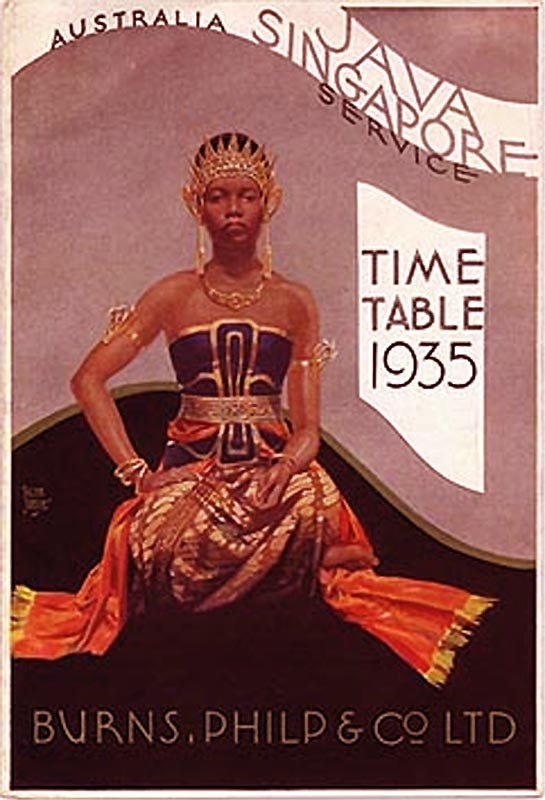
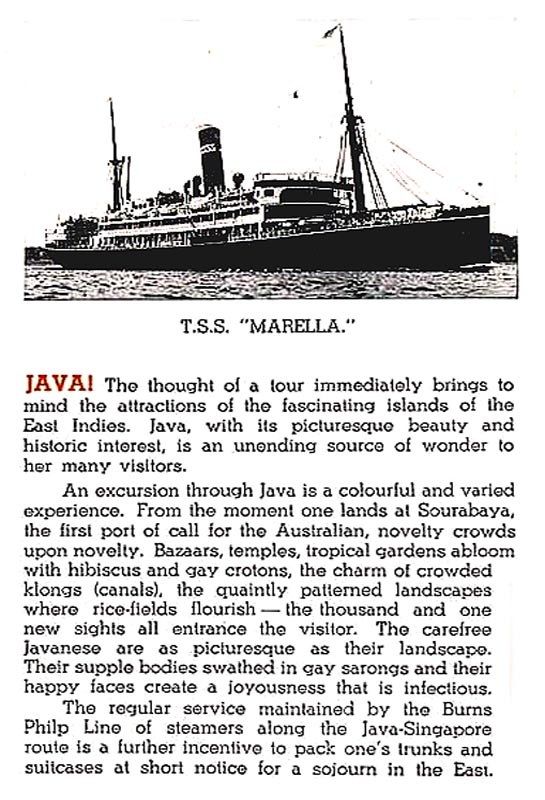
Sailing
Schedule cover; December 1934 to November 1935 and inside cover
Her ports were as follows: Melbourne,
Sydney,
Townsville, Thursday Island, Darwin,
Sourabaya, Samarang, Batavia
(Jakarta),
Singapore
and return.
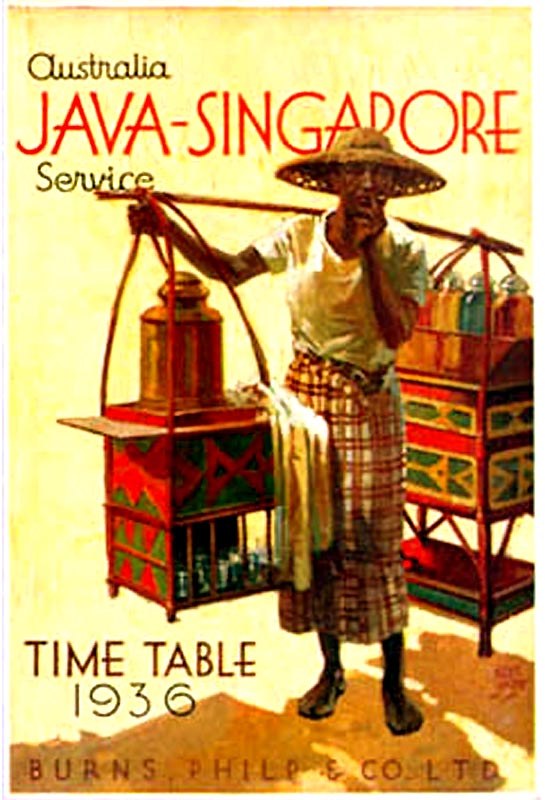
Sailing
Schedule; December 1935 to November 1936
As of December 1935 her ports
were as follows: Melbourne,
Sydney,
Brisbane,
Townsville (optional), Thursday Island, Darwin,
Sourabaya, Samarang, Batavia & Singapore. She could also call at
other Queensland
and Javanese ports depending on cargo requirements.
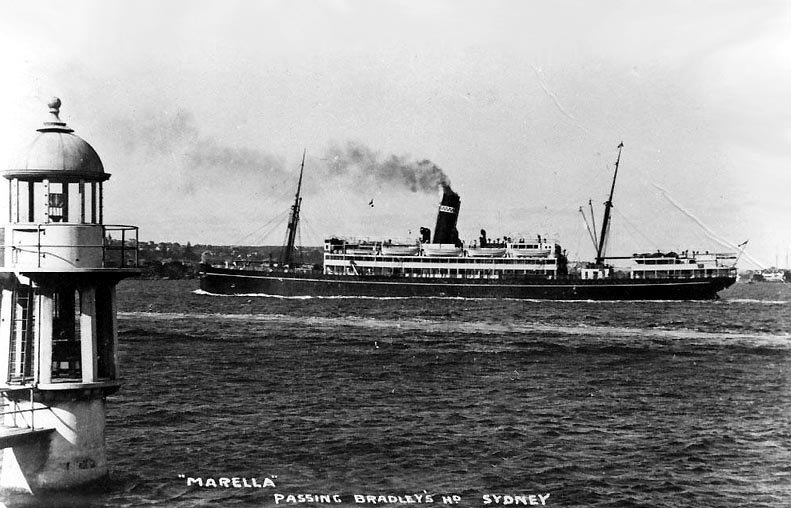
A
fine postcard of the T.S.S.
Marella
passing Bradley’s
Heads, Sydney
A Great Ballerina Tours
Queensland
in 1929/1930:
T.S.S.
Marella
arrived in Townsville (Queensland,
Australia)
on the morning of March 23, 1929, on board was the world famous extraordinary
passenger Ballerina Anna Pavlova. Of course it was pre-arranged that photographers and the press
would be able to come on board and Miss
Pavlova
posed in a deckchair for a photographer after which she left this beautiful
ship, and she had greatly enjoyed her voyage on her, even though there had been
a last day of poor weather. As she stepped ashore Anna
Pavlova
was greeted by the countless locals who had gathered at the dock to greet the
world’s most famous ballet dancer.
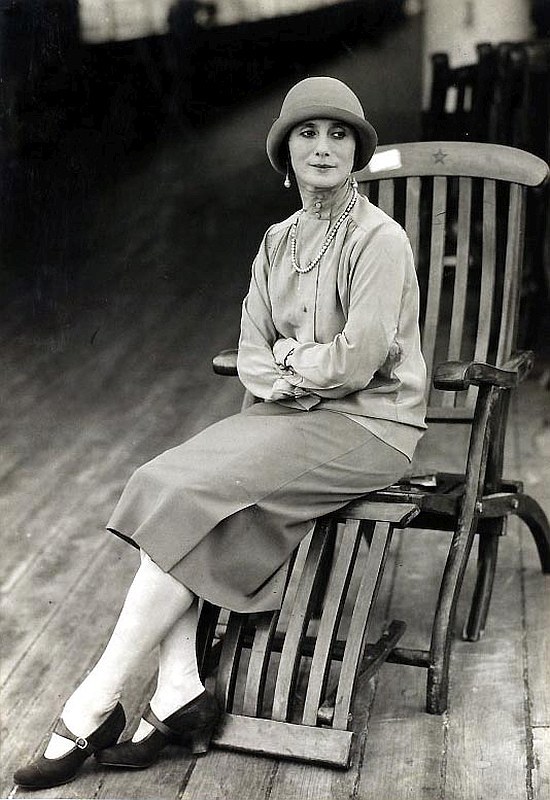
Anna
Pavlova
poses in a deckchair on board the T.S.S
Marella
With grateful thanks to
the Mitchell
Library
Pavlova
was accustomed to taking her art to the world for over 15 years, but this was
to be the beginning of one of the strangest tours of her life.
Over the next week she and her extensive troupe of dancers travelled through North
Queensland
on a whistle stop tour, travelling on a train that was especially provided for
her by “Queensland Railways”.
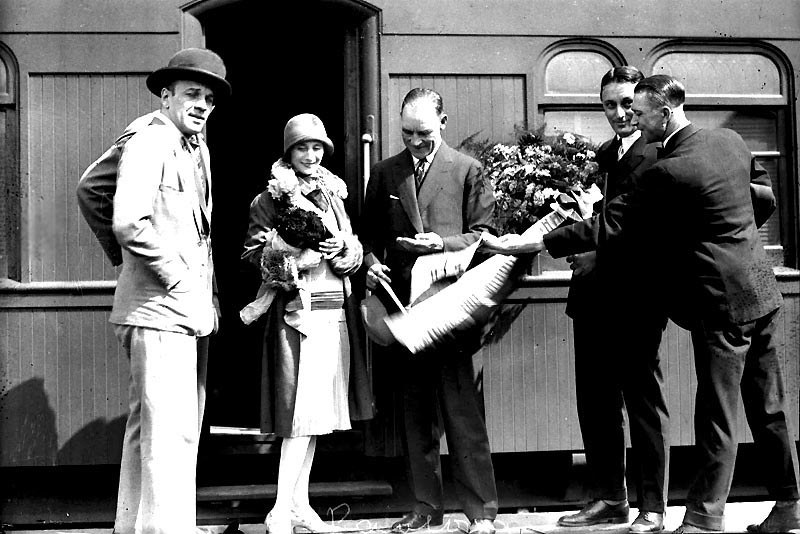
The
Pavlova Train supplied by Queensland Railways
With grateful thanks to
the Mitchell
Library
The reason why she disembarked and danced in
Townsville first was as follows.
The 1929 tour should have made its official
opening in the Capital
City
of the State of Queensland
“Brisbane”;
however the “Marella” had been delayed by some poor weather
conditions, but also some loading problems in Singapore
during Miss
Pavlova’s
voyage from Surabaya
to Australia.
In addition the ship had to stop briefly in Darwin
for cargo reasons, prior to heading for Townsville, and other ports of call at
the last minute was all part of the ships and passenger contract, which had
been agreed upon by the passenger before departure.
However, there was also another and a greater
problem, but this had been at the Brisbane
end, for the first performances of the tour were scheduled for J.
C.
Williamsons’ newly
refurbished Brisbane
Theatre, “His Majesty’s” in Queen
Street, in the City centre. But sadly many
renovations tend to run late and this one was no exception to say the least!
Whilst the ballet troupe was still in
south-east Asia, Australia
had cabled Victor
Dandre,
Pavlova’s
manager and de facto husband:
“Can
you extend Eastern tour, arriving Brisbane
second April. Failing this propose arranging Townsville, Mackay, Rockhampton,
Bundaberg, Maryborough, before Brisbane”.
Early in February 1929, Dandre
replied:
“Impossible
extend tour must leave Surabaya
March 8 arriving Townsville 19, stop. How many performances you think given in
small cities. We could give two different programs composed of one ballet and
two acts of divertissements. Without scenery in black curtains, stop”.
And therefore the provincial tour itinerary
was settled, but they had to cancel their date at Maryborough.
In Townsville, the first show took place at
the Wintergarden Theatre on March 23, the very day as the ship arrived. The
performance commenced rather late, and as you can imagine there were rushed
rehearsals at the theatre as the travelling trio, being a pianist, cellist and
a violinist were supplemented by a locally recruited small orchestra, who were
faced with the scores for “Walpurgis Night”, “The Fairy Doll”,
and six divertissements, including the famous “Dying Swan”.
After a second show on March 25, the company
travelled overnight to Mackay for one performance at the packed out Olympic
Theatre on March 26, then on to Rockhampton the following day. The critic for
The Rockhampton Morning Bulletin was so excited by the show at the local
Wintergarden that they a raving review including some lines from Shakespeare’s
poem “Venus
and Adonis”.
After the show the dancers raced back to the
station for their third overnight train journey, this time to Bundaberg on
March 28, where there had been a great deal of advance publicity in the local
Daily News and another greatly loved performance! It was back on the train the
next day for their final journey to Brisbane.
The company opened in Brisbane
on March 30 for an 11-performance run, for which locals queued from early in
the morning every day in order to obtain their tickets.
It
was sad that Anna
Pavlova’s
Australian audiences were among some the last to see the great Ballerina dance.
Her long Australian tour finally ended in July 1930, as Anna
Pavlova
passed away on January 23, 1931, aged just 49 from Pleurisy whilst performing
in The
Hague,
the Netherlands.
But her great legacy lives on and she will never be forgotten!
I have always greatly loved Classical Music,
Opera and the Ballet, Reuben
Goossens.
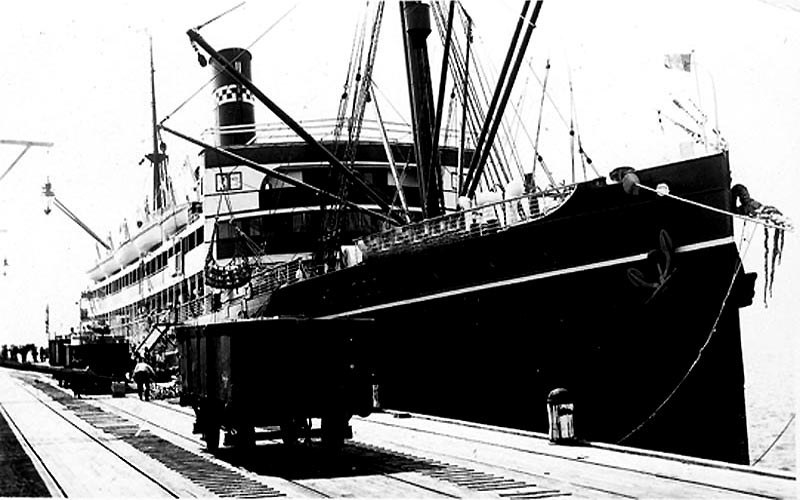
The
Marella is seen on one of her rare visits’ to Portland
located south-west of Victoria
It
is around 355 klm west from Melbourne
***********************************
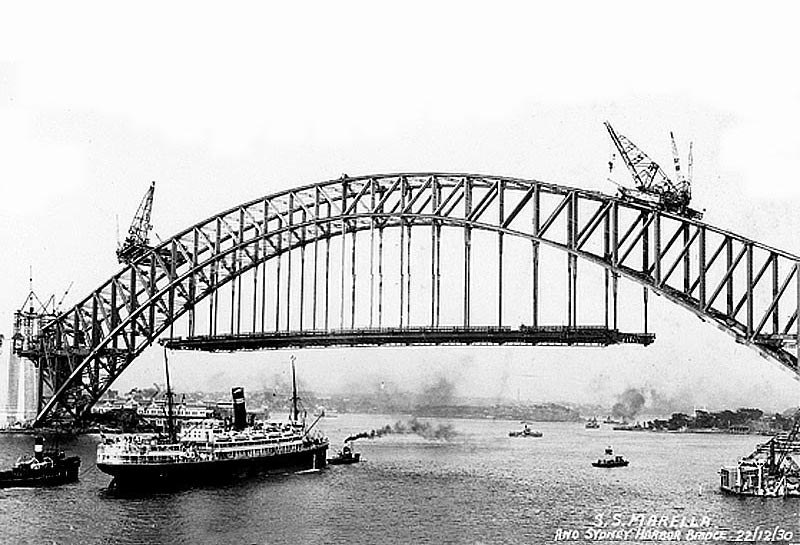
A
postcard of the Marella is seen in Sydney
during the construction
of the Sydney
Harbour
Bridge
on December 22, 1930
The Marella continued to be a greatly favoured
ship with the public and she tended to be fully booked in both classes, both
for round voyages, as well as passengers travelling one way to and from various
ports.
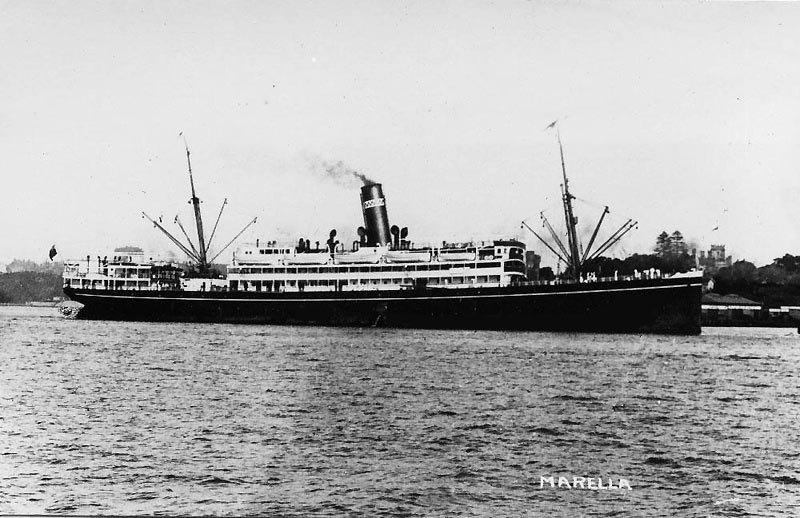
A
postcard of the T.S.S.
Marella
leaving Brisbane
heading towards Moreton
Bay
and then out to sea
However, as the 30’s was coming to an
end, it became obvious that War was heading our way!
World War Two:
The T.S.S.
Marella
was required for War duties from 1939 to 1945. At first between 1939 and 1941,
the Marella transported troops and passengers from southern Australian ports to
Darwin
and Singapore
thankfully without incident. On December 3, 1941, during a voyage to Singapore
the Marella was stopped in Darwin
by the Australian Naval Authorities and after she discharged her cargo, she
then had to transfer all her passengers to the Burns Philp that had arrived,
the 4,057 GRT, S.S.
Montoro
which would continue the voyage.
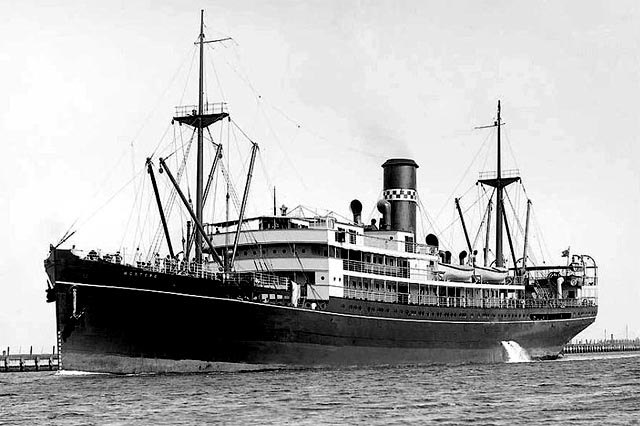
The
S.S.
Montoro
1911 to 1955
(Use
the link to her feature located at the bottom of this page)
Photograph provided by Mr.
David
Levinson
Liverpool
UK
The Marella would now make 24 voyages to and
from Darwin.
One of these voyages included when the 2/4 Machine Gun Battalion embarked in Darwin
on December 30, 1941, and she headed for Port
Moresby.
Later in 1942 the T.S.S
Marella
was taken over by the Australian Commonwealth Government, and she was taken to
a shipyard where she was armed and provided with naval gunners, yet she was
never officially Commissioned by the Navy.
She now sailed flying the Red Ensign and was
still crewed with Burns Philp Merchant seaman, but the Navy utilised her to
carry troops, guns, stores, munitions etc for forces wherever they were located
in Asia and the Pacific.
She carried troops to Torokina
on Bougainville,
but on nearing Torokina with a US Pilot in control,
believe it or not, the Marella ran aground but was soon refloated.
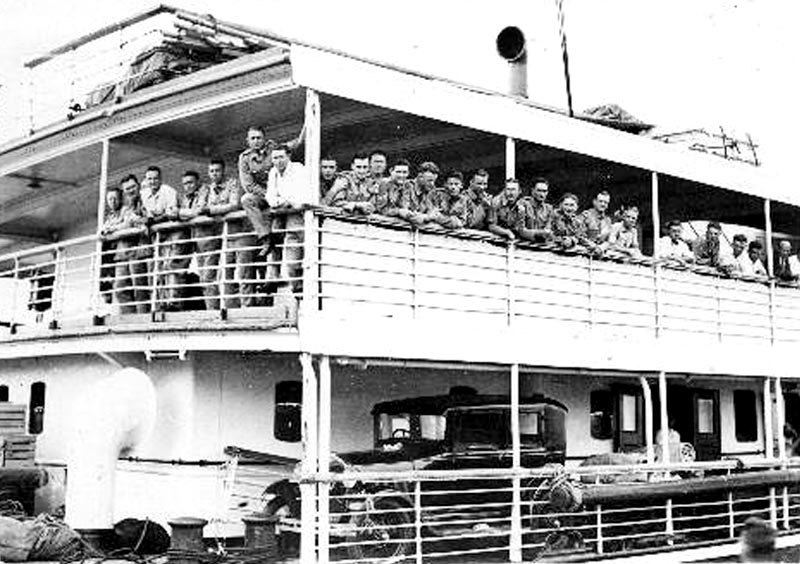
The
Marella is seen with Troops on board
Amazingly in 1945, a New
Zealand
aircraft on take off mistakenly dropped a bomb, which exploded in the harbour
close by the Marella and the blast bent the Marella’s propeller blades.
However, she managed to limp back to Sydney
where she headed into dry-dock arriving on November 12,
1945.
Her Final years with Burns
Philp:
T.S.S. Marella
was returned to Burns Philp in 1946, and she was also given a refit ensuring
that she was her luxury old self! She
returned to her original service Australian ports to Indonesia
and Singapore,
and she continued until late in 1948. The truth was that the old girl was now
almost 35 years old, and it was decided to sell her as new ships had joined the
fleet. One of these was the magnificent 6,397 GRT, T.S.M.V.
Bulolo,
which I have her online together with other Burns Philp ships. (Use the link to
her feature located at the bottom of this page).
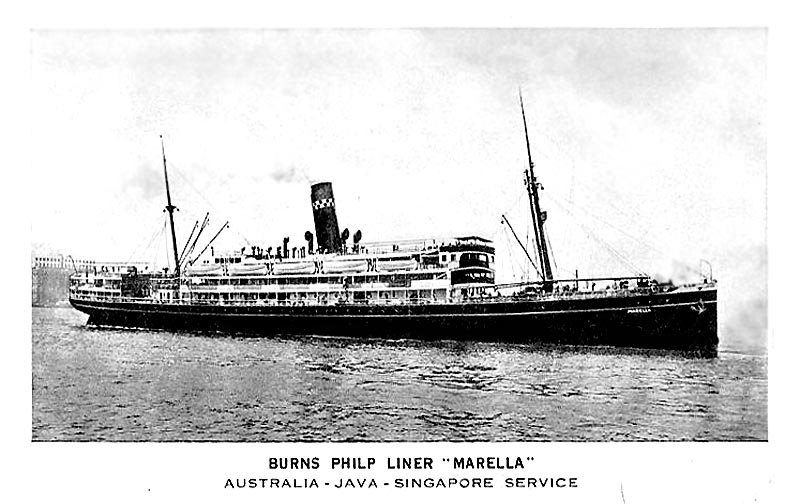
A
final postcard of the T.S.S.
Marella
It was a sad day when the still beautiful
looking T.S.S.
Marella
departed Sydney
for the very last time on Tuesday November 2, 1948, bound for Singapore,
as she had been sold to an Italian owned, but Panamanian registered shipping
company named, “Cia Navigation”.
The ships sad final years:
Upon arrival in Singapore
the Marella was handed over to her new owners who renamed her, “Captain
Marcos”.
She then departed Singapore
and headed for Italy
where she was refitted, with one of the major changes was that most of her
cargo spaces were converted into the most basic of passenger accommodations,
being mainly huge dormitories, for males and females, with the most basic
toilet and bathing facilities. Upon completion in October 1949, she was now
able to accommodate 950 passengers on a ship small ship that was designed to
have no more than 250 passengers.
S.S. Captain Marcos
commenced her new career by making a single voyage from Genoa
to Valparaiso
in Chile
in October 1949, then for some reason the company renamed her “Liguria”. During
the summer months of 1950 she was used to transport “Holy Year”
Pilgrims from the USA
to Italy
and they would head to Rome
and enjoy all the celebrations there, after which they would return to the US.
In the meantime the company had managed to
obtain an official charter from the “International Refugee
Organisation” (IRO), and take displaced persons who were chosen to go to Australia
on a ship that became better known as a “Hell at Sea!”
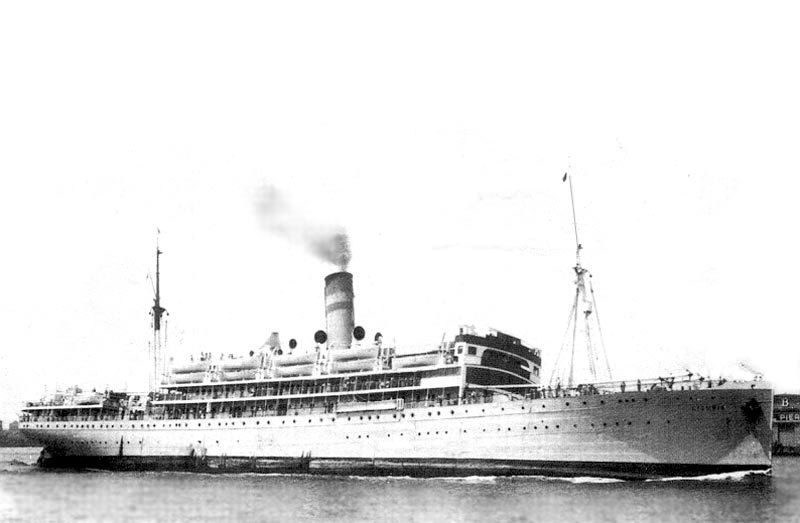
The
S.S.
Liquria
she looks OK externally, but her interiors were not what they used to be, to
say the least
Then on November 19, 1950, S.S. Liguria
departed Bremerhaven,
Germany
bound for Newcastle,
Australia
with 950 IRO refugees packed on board, many were Jewish families from Hungary,
Yugoslavia
and Poland
and others displaced persons from the same regions. This, what was considered
as a small ship was so over crowded and for ladies with babies, the voyage was
to say the least terrible, for they seldom managed to get out of their
accommodations in order to get a breadth of fresh air, and the ship always
seemed to smell so bad. Passengers did note that the ship was far slower than
what she should have been, and once they had passed through the Suez Canal and
entered the Indian Ocean they had no idea that there were serious problems down
in the engine room, and then suddenly one day the ship came to a complete stop
and they knew that they were so close to Australia, yet way out at sea.
On January 12, 1951, as the Liguria
was wallowing in heavy seas in the Indian Ocean around 450 miles from the
port of Fremantle
(Perth), for those problems down below had
suddenly come to the fore, as she there was a major engine problem and the Liguria
finally broke down and could go no further. The captain radioed Perth
for aid.
The first ship to arrive was another IRO ship,
the 7,821-ton S.S.
Florentia
with 1,300 persons aboard on Saturday January 13 and she remained with Liguria
for 14 hours, until a ship arrived, which was more powerful to tow her to
Fremantle faster.
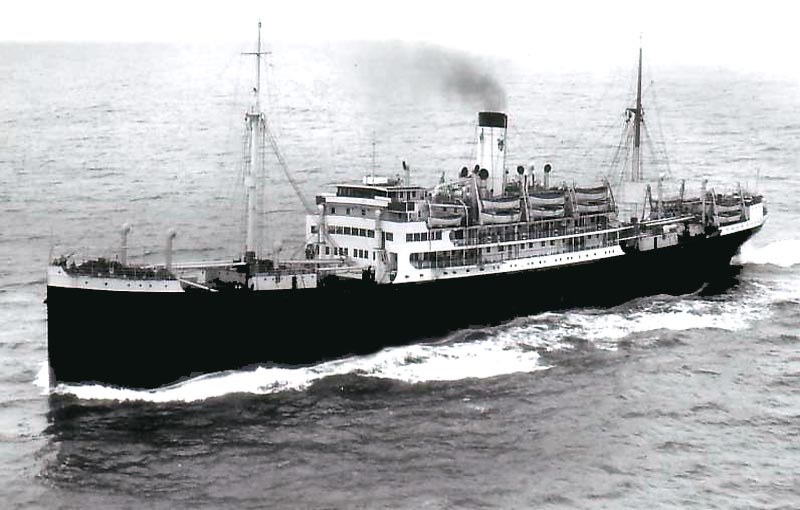
The
S.S.
Florentia was another
over crowded migrant ship, which was owned by the same company as the S.S.
Liquria
PS: In 1952, the Florentia was painted all
white and was given the same funnel livery as the Liquria
For the record, I have added some of the
News Paper articles below regarding the incident;
“The WEST AUSTRALIAN”
Perth,
Wednesday 17, 1951
MIGRANT SHIP STANDS BY THE LIGURIA
FOR 14 HOURS
“After having stood by the disabled migrant ship Liguria
(7,475 tons) off the West Australian coast for 14 hours during the weekend, the
Italian-manned migrant vessel Florentia (7,821 tons)
reached Fremantle yesterday. She was the first vessel to go to the assistance
of the Liguria.
The master of the Florentia (Capt.
L.
Vincenzo)
said yesterday that arrangements were being made on Saturday for his ship to
take the Liguria
in tow when it was learnt that the British freighter Chandpara was going to the
assistance of the crippled vessel
It was considered preferable that the Chandpara should
undertake the tow because she had more speed than the Florentia,
which would have had to risk the possibility of at least another few days at
sea with 1,297 passengers aboard.
While he was standing by the Liguria,
Capt.
Vincenzo
said a motor launch was sent from the Liguria
requesting lubricating oil and supplies of sugar. “We were able to supply
the oil, which was for her engines,” he said, “but we were not able
to send her any sugar. We had 620 children aboard the Florentia
and we needed what supplies of sugar we had for them.”
At the time, the Liguria's
engines were stopped. He was not able to ascertain the cause or degree of
seriousness of the engine trouble, but the second message he received from the Liguria
on Friday asked for immediate assistance. The Florentia
reached the Liguria
at 12.10 p.m. on Saturday and did not resume her voyage to Fremantle until 2.20
a.m. on Sunday. By this time, the Chandpara had arrived to take the Liguria
in tow”.
SHIPS DUE TODAY
“Good progress was being made with the 450-mile tow to
Fremantle yesterday and, according to a report received from the Chandpara, the
vessels are expected to reach Gage Roads about noon today. The tug Uco may then be called on to assist in the berthing of the Liguria
at No. 8 North Wharf.
As it is possible that the Liguria
will be delayed at Fremantle for some time while engine repairs are carried
out, it is expected that the 930 displaced persons in the vessel will be
transferred to the “Nelly”,
at present at Fremantle is awaiting orders. The displaced persons are bound for
Newcastle
in New
South Wales”.
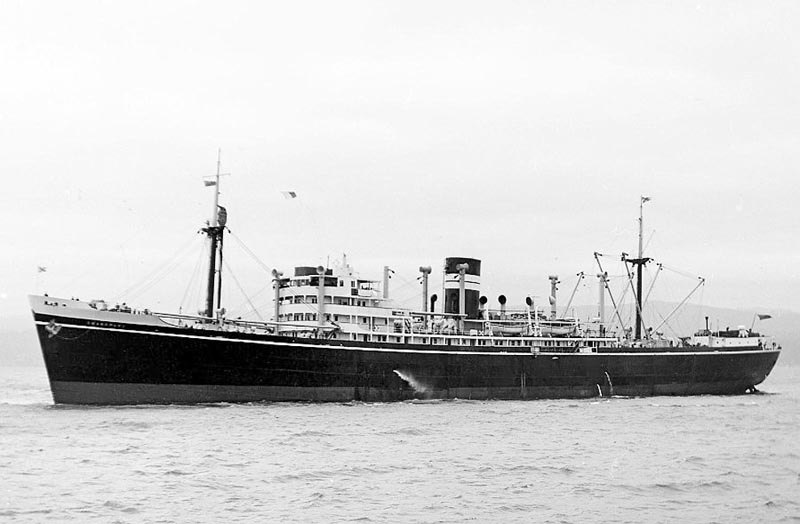
M.S.
Chandpara
“The West Australian” (Perth)
reported on Monday 15, 1951:
DISABLED MIGRANT SHIP IN TOW
Aid
from Freighter - After a Tug Pay Dispute & Deadlock
“After
wallowing in heavy seas 450 miles north-west of Fremantle for more than two
days, the disabled Panamanian migrant ship Liguria
(7,475 tons), with 930 displaced persons aboard, was taken in tow yesterday by
the British freighter Chandpara (7,274-tons). They are expected to reach
Fremantle about Wednesday morning.
On Saturday
night, after a conference with their Communist union official, crew members of
the tug Uco refused to take their tug to sea to go
and to the aid of the Liguria
because of a deadlock over wages and conditions for the trip.
On learning
of the deadlock late on Saturday, the Liguria's
agent at Fremantle (Mr.
R.
G.
Lynn)
arranged for the SS
Chandpara
to be diverted to the vessel's assistance. The Chandpara reached the crippled
migrant ship about 1 a.m. yesterday and the tow started at 8 a.m. Later in the
day it was reported that a speed of six knots was being maintained and the
seas, which had been rough, were moderating. The ship had one engine completely
out of commission as well as other mechanical problems.
Another
passenger vessel, the Florentia (7,821 tons), with
1,300 persons aboard, also altered course to go to the assistance of the Liguria
early yesterday. Later in the morning when it was realised that the Chandpara had
reached the disabled vessel, the Florentia resumed
her voyage to Fremantle, where she is now due today instead of late yesterday.”
Although the newspaper story above stated that
the Liguria
“is now due today” the 16th, but she really arrived at Fremantle on
Wednesday January 17.
Her passengers disembarked and thankfully her
passengers were able to board another much better and far more reliable German
migrant ship, the M.S.
Nelly
which would take them to their destination at Newcastle.
Passengers noted that suddenly they received ample clean drinking water, fruit
juices and ample good food, something they had not received on the Liguria
as well the Nelly
was spotless!
The Liguria
remained in Fremantle for a huge list of repairs that would take until August
to complete. Whilst she was in the shipyard for repairs, also there were number
legal writs and finally a massive repair bill.
Renamed again:
After the repairs were completed in August
1951, she was immediately renamed “Corsica” and she returned to Europe
to commence her next voyage from Limassol.
S.S. Corsica was “Hell at Sea”:
This now rapidly aging ship was about to
undertake her next voyage, and she was sent to Limassol in Cyprus
where she was to collect 761 Cypriot migrants who had paid their passage to Australia
on December 12, 1951 - BUT?
The Corsica departed Limassol late with 761
Cypriot migrants for Australia,
and she was the first ship to leave Cyprus
with so many emigrants. She for Fremantle and Melbourne
and was due to end her voyage in Sydney
(BUT?). The voyage was described by a woman passenger as “Hell at Sea” for the ship was nothing
more than “a floating slum, due to the
horrendous conditions on this ship”.
Although the Corsica was scheduled to depart Limassol
on December 12, but the truth is that she simply did not turn up on the
scheduled date, but she arrived a day late, which caused her all her awaiting
passengers much grief and great discomfort to say the least as you will soon
discover. Thus the Corsica arrived and departed Limassol on December 13, with
her ports of call being; Port Said (Egypt),
then proceeding through the Suez Canal to Massawa (Eritrea),
then Djibuti (French Somalie),
next Colombo (Ceylon)
then arriving at Fremantle (Australia) on
January 25, 1952. This now miserable and very tired old ship was delayed at
Fremantle for a few days by the Australian Government before it was allowed to
continue its voyage to Melbourne
and Sydney,
although she never made it to Sydney
as I will explain below. Those passengers who were due to go to Adelaide
in South
Australia
disembarked in Melbourne
and the Australian Government had arranged passage on a train to the City of Adelaide.
However, this voyage was without a doubt a
disgusting experience, and certainly not one that was fit for human beings,
just like her passengers so clearly recorded. Apparently there were countless
problems experienced throughout the voyage on the Corsica,
and I have been told that this include “a cargo of rotting potatoes that
stank throughout the ship, and the absence of fresh drinking water throughout
the voyage as well as filthy toilets that were hardly fit for humans to use, in
addition, they were permitted just one sea water shower per week,” and
the list just went on.
I was advised that that once the ship departed
Limassol on December 13, 1951, it became almost immediately apparent that there
was a terrible smell throughout the ship. It was discovered that there were a
hold full of sacks with rotten potatoes that had ruined and rotted due to the
heat and humidity even prior to the ships arrival, a passenger stated the
following;
“Hell at Sea”:
“For
some weird reason it was not until the ship eventually docked in Colombo
that was a month later, that the captain ordered the crew to dump those filthy
stinking potatoes overboard into the ocean. But, even after they had been
finally dumped, that terrible stink remained throughout the ship for the rest
of the voyage, which we were forced to suffer. And our hell just kept on going
and we could not wait to get off this hell hole! This ship from the day we
boarded until we were finally got off her was like being on Hell at Sea.”
Below are just some more S.S. Corsica passengers recollections, they are sad stories indeed. All
these stories were provided to me by the now; late Mr.
Costas
Michaelides.
Please Note:
The stories below had been slightly edited for readability sake and flow, but
they remain completely in context.
Our Voyage on the S.S.
Corsica:
“I was
only a young man when I sailed on the Corsica
and I was travelling with some of the men from my village. The Corsica
was due to depart Limassol on December 12, 1951, but when we arrived there with
all our families, we discovered that the ship for some reason had not arrived.
Thus we had no choice but to stay the night in Limassol. There were so many
people stranded there, and no-one knew what was going on, or why our ship was
not there. There were of those who had sufficient money and they were able to
find some sleeping quarters. Then the Corsica
arrived the next day and believe me, that ship looked nothing like we were told
by the travel agency staff back at home. Even before we left Cyprus,
the ship was a huge disappointment. When we arrived in Colombo,
we were told that the ship had to stay there for four days as some repairs
where required to be done and also they had to dump those stinking potatoes
into the sea that had plagued us since early in the voyage. Also the ship had
to refuel. The gangplank from ship to shore certainly was not very safe for I
remember one poor mother and her daughter who fell into the water between the
ship and the wharf as they were walking down that rickety gangplank. Luckily,
some men who were able to swim jumped into the water and saved them.”
“Ship of
Horrors”:
“I was
a seventeen old girl when I sailed on this ship of horrors, the Corsica.
I was with my brother, and we where on our way to be with our family in Australia.
I remember the stench from the rotten potatoes on-board. The conditions on-board,
especially the toilets were just beyond disgusting for they were cleaned on an
occasional basis, if lucky, I honestly don’t know how we survived it. We
were allowed to have a shower just once a week using some horrible soap that
would not even lather. It was all very difficult and we thanked God when we
were allowed to get off this ship.”
“A floating Prison
and it was more like a Slum”:
“The
truth is the ship was more like a floating prison and it was more like a slum,
as we were living in conditions we had never lived in. It is not that we did
not pay, almost everyone had to borrow money and to buy passage on this hell
ship, but we never received a ticket, when we finally board, and that was a day
late, your name had to be found on a passenger list. On board the food was so
boring, day in day out we were given ‘macaroni’ by the Italian
waiters who could not communicate with us, and then our food came on horrible
tin plates. Nothing was ever arranged, thus not a single announcement was made,
and there was not any entertainment of any kind. Many of us would end up in the
kitchen and helped ourselves to any food we could find especially if there were
good cooked potatoes, so we peeled then and eat it, for we were starving.
Sleeping in our crowded quarters was so hot and humid and smelly because of
those rotting and stinking potatoes in a hold somewhere, so often most would go
out on deck and sleep there, it was far from comfortable, and not what my
travel agent promised!”
The stories above are just some of those I
have was given and believe me, these are not even the worst: This was also the
first time that so many Cypriots emigrated at the one time directly on a ship
from Limassol; also it was the very first time, as records show that it the
voyage was so “horrendous of any migrant ship previously” that for
the very first time a migrant ship was discussed by ministers in the
“Australian Federal Parliament”.
Although she was due to sail as far as Sydney,
but whilst the Corsica was in Melbourne
on February 7, she was placed under arrest, due to a passenger who was owned
money for work he had done whilst he was on board. As the ship was unable to go
any further, passengers who were heading for Sydney
where placed on a train to reach their destination. Below is a part of a local
New Paper Clipping:
*GREEK SHIP CORSICA
ARRESTED
MELBOURNE.
Thursday February, 7, 1952
“Greek
ship Corsica
was arrested at its berth at Port Melbourne today. When the ship arrived this
week she was described by passengers as a “hell-ship.” A black
stowaway was taken off, and the waiters demonstrated for extra money for
working in what they described as “dirty and obnoxious conditions aboard.”
Today law
officers boarded the ship at Princes’ Pier and tied a Supreme Court writ
to her mast, as reporters began to read it, crewmen tore it down. The pressmen
were then requested to leave the ship and guards were placed at the gangway.
The writ,
taken out by a passenger named Mr.
Vladimir’s
Petrou;
alleged non-payment for work carried out between January 7 and February 2, and
claimed unspecified damages.
The writ may
delay the ship's departure from Melbourne.
In any case, she could not sail the remainder because when she moved from
Station Pier to Princes Pier for bunkering today a towrope fouled the
propeller. Officers who tried to free it said that it could only be cleared by
divers”. (*Of course
papers get things wrong, the ship was actually Italian owned).
Two weeks later the S.S. Corsica was released
and she headed back to Europe making a brief call into Adelaide
on February 24.
Sadly there is nothing much recorded in regard
of what happened to her after her return to Italy,
but record simply show that headed to Casablanca
in August 1952 and she remained idle there for just over two years.
Then in October 1954, she was sold to a
Belgian ship breaker who had her towed to Ghent
in Belgium
where she was duly scrapped aged a good 40 years.
***********************************
Ships Specifications
& Details:
Owners: Woerman
Line.
. Burns
Philp & Co Ltd.
. Cia Navigation.
Ship: T.S.S. “Marella”.
Official Number: 143170.
Type of Ship: Passenger-Cargo
Liner.
Built at: Reiherstieg Co, Hamburg
Germany.
Construction: Steel.
Launched: June 6, 1914 as
the “Hilda
Woermann”.
Completed; November
1917, renamed “Wahehe”.
Then Named: October
1920 “Marella”.
. November 1948, “Captain Marcos”.
. October 1949, “Liquria”.
. August 1951, “Corsica”.
Tonnage: 7,475
GRT, 4,340 NET.
Length: 426
ft - 129.8 m.
Width: 55.8
ft - 17 m.
Draught: 35.2
ft - 10.71 m.
Power: Quadruple
Expansion Steam Engines.
Propellers: Two.
Speed: 14
Knots.
Passengers: 1920
- 165 First & 75 Second Class.
. 1948 - 929 steerage.
. 1950 - 950 steerage
Crew: 1920
to 1948 - 125.
. 1949 to 1952 - Unknown.
Broken Up: Ghent
Belgium
in December 1954.
In Conclusion:
Even though her final five years where, to say
the least pathetic and sad times for what had been a magnificent Luxury
Passenger-Cargo Liner, but I believe we should always remember her as that fine
Australian liner the T.S.S. Marella!
Remembering
the Delightful Australian Liner
T.S.S.
Marella
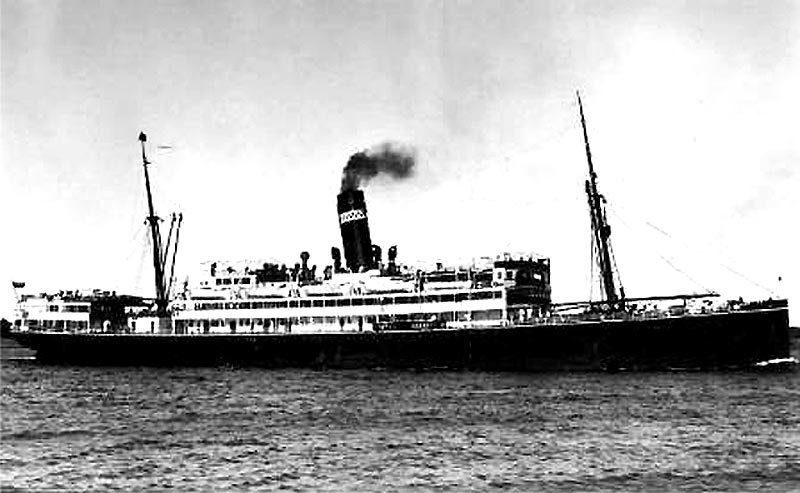
She
served Burns Philp & Co Ltd well from 1920 to 1948
Other Burns Philp Features Online
Also visit the TSMV Bulolo Feature
And read about
the 1911 S.S. Montoro
***********************************
“Blue Water Liners
sailing to the distant shores.
I watched them come, I watched them go and I watched them die.”
Return
to the ssMaritime MAIN INDEX
ssMaritime.com
& ssMaritime.net
Where you will discover over 1,355 Classic Liners & the 1914 built MV Doulos
Story
The
Author has been in Passenger Shipping & the Cruise Industry for a good 60
years!
Please Note:
ssmaritime and associated sites are 100% non-commercial and the author never
seeks any funding or favours of any shape or form, never have and never will!
Photographs on ssmaritime and associate pages
are: by the author or from the author’s private
collection. In addition there are some images that have been provided by
Shipping Companies and private photographers or collectors. Credit is given to
all contributors. However, there are some photographs provided to me without
details regarding the photographer/owner concerned. I hereby invite if owners
of these images would be so kind to make them-selves known to me (my email
address may be found on www.ssmaritime.com only), in order that due credit may be
given.
This notice covers all pages:
although, and I have done my best to ensure that all photographs are duly
credited and that this notice is displaced on each page, that is, when a page
is updated!
ssMaritime is owned & © Copyright
by Reuben
Goossens
- All Rights Reserved






















